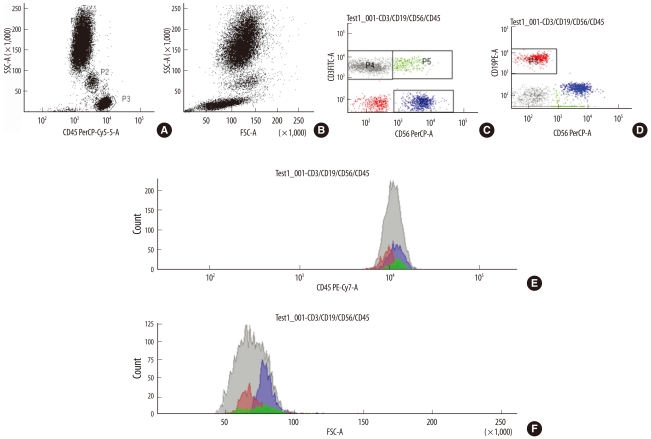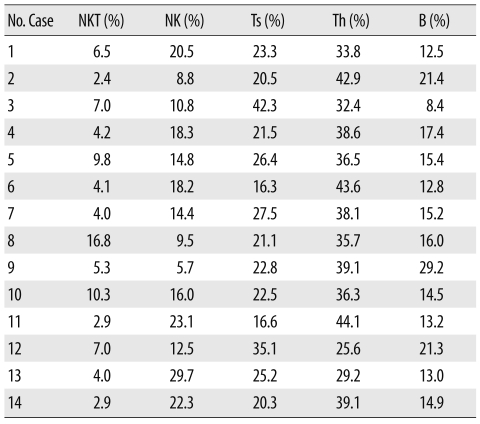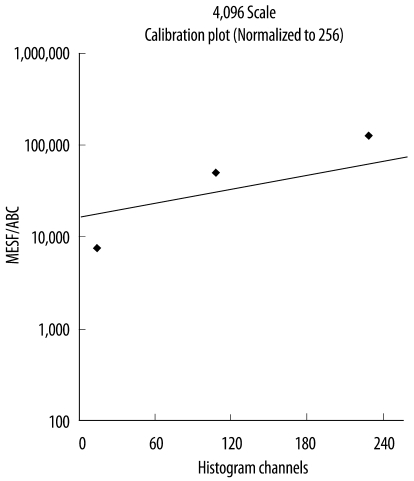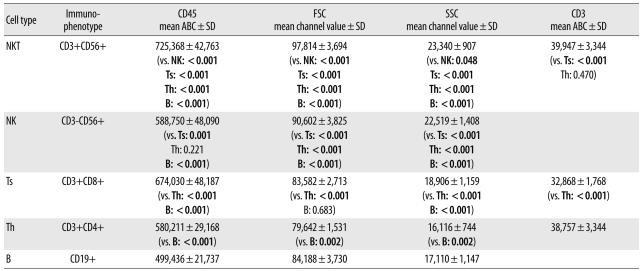1. Kee SJ. The Korean society for laboratory medicine. Laboratory evaluation of the cellular immune system. Laboratory medicine. 2009. 4th ed. Seoul: E public;p. 601–610.
2. Abbas AK, Lichtman AH, editors. Cellular and molecular immunology. 2010. 6th updated ed. Philadelphia: Saunders;p. 137–152.
3. Falahati R, Leitenberg D. Selective regulation of TCR signaling pathways by the CD45 protein tyrosine phosphatase during thymocyte development. J Immunol. 2008; 181:6082–6091. PMID:
18941197.

4. Elder ME. Detrick B, Hamilton RG, editors. Investigation of signal transduction defects. Manual of molecular and clinical laboratory immunology. 2006. 7th ed. Washington, D.C: ASM Press;p. 901–905.
5. Panchal RG, Ulrich RL, Bradfute SB, Lane D, Ruthel G, Kenny TA, et al. Reduced expression of CD45 protein-tyrosine phosphatase provides protection against anthrax pathogenesis. J Biol Chem. 2009; 284:12874–12885. PMID:
19269962.

6. Green DJ, Pagel JM, Pantelias A, Hedin N, Lin Y, Wilbur DS, et al. Pretargeted radioimmunotherapy for B-cell lymphomas. Clin Cancer Res. 2007; 13:5598s–5603s. PMID:
17875795.

7. Lin Y, Pagel JM, Axworthy D, Pantelias A, Hedin N, Press OW. A genetically engineered anti-CD45 single-chain antibody-streptavidin fusion protein for pretargeted radioimmunotherapy of hematologic malignancies. Cancer Res. 2006; 66:3884–3892. PMID:
16585217.

8. Pagel JM, Hedin N, Subbiah K, Meyer D, Mallet R, Axworthy D, et al. Comparison of anti-CD20 and anti-CD45 antibodies for conventional and pretargeted radioimmunotherapy of B-cell lymphomas. Blood. 2003; 101:2340–2348. PMID:
12446461.

9. Green DJ, Pagel JM, Nemecek ER, Lin Y, Kenoyer A, Pantelias A, et al. Pretargeting CD45 enhances the selective delivery of radiation to hematolymphoid tissues in nonhuman primates. Blood. 2009; 114:1226–1235. PMID:
19515724.

10. Broome HE. Lichtman M, editor. Morphology of lymphocytes and plasma cells. Williams hematology. 2006. 7th ed. New York: McGraw-Hill;p. 1023–1030.
11. Trinchieri G, Lanier LL. Lichtman M, editor. Functions of natural killer cells. Williams hematology. 2006. 7th ed. New York: McGraw-Hill;p. 1077–1082.
12. Thompson CB, Scher I, Schaefer ME, Lindsten T, Finkelman FD, Mond JJ. Size-dependent B lymphocyte subpopulations: relationship of cell volume to surface phenotype, cell cycle, proliferative response, and requirements for antibody production to TNP-Ficoll and TNP-BA. J Immunol. 1984; 133:2333–2342. PMID:
6207226.
13. Iritani BM, Eisenman RN. c-Myc enhances protein synthesis and cell size during B lymphocyte development. Proc Natl Acad Sci USA. 1999; 96:13180–13185. PMID:
10557294.

14. Perillo NL, Naeim F, Walford RL, Effros RB. In vitro cellular aging in T-lymphocyte cultures: analysis of DNA content and cell size. Exp Cell Res. 1993; 207:131–135. PMID:
8319764.

15. Press OW, Farr AG, Borroz KI, Anderson SK, Martin PJ. Endocytosis and degradation of monoclonal antibodies targeting human B-cell malignancies. Cancer Res. 1989; 49:4906–4912. PMID:
2667754.
16. Carulli G, Cannizzo E, Zucca A, Buda G, Orciuolo E, Marini A, et al. CD45 expression in low-grade B-cell non-Hodgkin's lymphomas. Leuk Res. 2008; 32:263–267. PMID:
17692374.

17. Ratei R, Karawajew L, Lacombe F, Jagoda K, Del Poeta G, Kraan J, et al. Normal lymphocytes from leukemic samples as an internal quality control for fluorescence intensity in immunophenotyping of acute leukemias. Cytometry B Clin Cytom. 2006; 70:1–9. PMID:
16278833.

18. Bikoue A, George F, Poncelet P, Mutin M, Janossy G, Sampol J. Quantitative analysis of leukocyte membrane antigen expression: normal adult values. Cytometry. 1996; 26:137–147. PMID:
8817090.

19. Beverley P. The importance of T3 in the activation of T lymphocytes. Nature. 1983; 304:398–399. PMID:
6603576.
20. Lenkei R, Andersson B. Determination of the antibody binding capacity of lymphocyte membrane antigens by flow cytometry in 58 blood donors. J Immunol Methods. 1995; 183:267–277. PMID:
7602149.

21. Ginaldi L, Farahat N, Matutes E, De Martinis M, Morilla R, Catovsky D. Differential expression of T cell antigens in normal peripheral blood lymphocytes: a quantitative analysis by flow cytometry. J Clin Pathol. 1996; 49:539–544. PMID:
8813949.

22. Islam D, Lindberg AA, Christensson B. Peripheral blood cell preparation influences the level of expression of leukocyte cell surface markers as assessed with quantitative multicolor flow cytometry. Cytometry. 1995; 22:128–134. PMID:
7587743.






 PDF
PDF ePub
ePub Citation
Citation Print
Print






 XML Download
XML Download